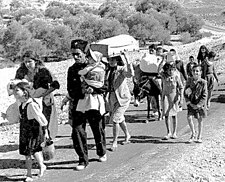Draft:Palestinian cultural genocide
| This is a draft article. It is a work in progress open to editing by anyone. Please ensure core content policies are met before publishing it as a live Wikipedia article. Find sources: Google (books · news · scholar · free images · WP refs) · FENS · JSTOR · TWL Last edited by Chris troutman (talk | contribs) 3 months ago. (Update)
Finished drafting? or |
| Part of a series on |
| Genocide |
|---|
 |
| Issues |
| 15th–19th century genocides |
| Early 20th century genocides |
| World War II (1939–1945) |
| Cold War (1940s–1991) |
| Contemporary genocides |
| Related topics |
|
| Category |
 |
| Part of a series on the |
| Nakba |
|---|
Within the Palestinian genocide accusation, the many instances of destruction of Palestinian cultural and intellectual heritage, as well as the killing of artists and intellectuals, are considered by many researchers and activists to amount to a cultural genocide.[1] Even before the Nakba, this erasing effort has taken many forms, such as - the replacement of place names with new ones in Hebrew, which is known to have started in the 1920's with “naming committee”;[2] the appropriation of archeological artifacts unearthed by Israeli institutions in occupied territory, to which Palestinian access is systematically denied,[2] as well as acts of vandalism, intentional bombing and demolition of archeological sites and the theft of artifacts in possession of Palestinian institutions;[3] the destruction of buildings and institution of religious, cultural and intellectual value, such as the Mughrabi Quarter, which was razed by Israeli forces in 1967;[4] the theft and destruction of Palestinian archives and libraries;[5] and also, beyond Palestine, Israeli forces destroyed and looted documents, books and artifacts preserved within Palestinian refugee camps, such as in Lebanon, during the 1982 Israeli invasion of Lebanon, which culminated with the destruction of the Palestine Research Center building.[6]
The most recent deflagration of the conflict, which has been raging since the end of 2023, has seen many cases of targeted destruction and killing of Palestinian cultural and intellectual heritage. In january of 2024, Unesco accounted 22 cases of verified damage - which includes five religious sites, three archeological sites, one museum, one monument, two depositories and ten building of historical and artistic value.[7] Others reports show a more extensive destruction, such as the complete destruction of Israa University, including the museum building which houses thousands of documents, materials, instruments and artifacts.[7] Al Jazeera Media Network reported at least two hundred sites of historic and cultural importance - such as the destruction of the Rafah Museum and the Al Qarara Cultural Museum.[8]
References[edit]
- ^ Abdullah 2019, pp. 227.
- ^ a b Abdullah 2019, pp. 230.
- ^ Abdullah 2019, pp. 231.
- ^ Abdullah 2019, pp. 232.
- ^ Abdullah 2019, pp. 235.
- ^ Abdullah 2019, pp. 237.
- ^ a b Kendall Adams, Geraldine (30 January 2024). "Widescale destruction of cultural heritage in Gaza". Museums Association. Retrieved 4 February 2024.
- ^ "A 'cultural genocide': Which of Gaza's heritage sites have been destroyed?". Aljazeera. 14 January 2024. Retrieved 4 February 2024.
Bibliography[edit]
- Abdullah, Daud (2019). "A century of cultural genocide in Palestine". In Bachman, Jeffrey (ed.). Cultural Genocide: Law, Politics, and Global Manifestations. London: Routledge. doi:10.4324/9781351214100. ISBN 9781351214100.
